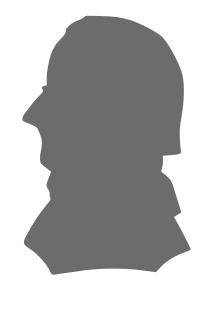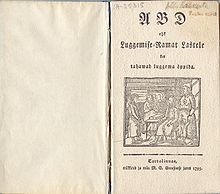Otto Wilhelm Masing
Otto Wilhelm Masing (* October 28 . Jul / 8. November 1763 greg. In Lohusuu , † March 3 jul. / 15. March 1832 greg. In Äksi ) was an Estonian pastor and linguist . He is the inventor of the letter Õ in the Estonian written language .
education
Masing was born in northern Tartumaa as the son of the sexton Christian Masick and his wife Anna Ludovica Hildebrandt (1724–1809). His father was an Estonian, his mother was German of Swedish descent, presumably of noble descent. The parents attached great importance to the boy's education from an early age. He was also supported by the pastor of Torma-Lohusuu, Franz Gotthilf Friedrich Asverus, who had studied in Jena .
Masing attended the city school of Narva from 1777 to 1779 and the grammar school of Torgau in Germany from 1779 to 1782 . He then studied theology , music and drawing at the University of Halle . In addition, he discovered a special talent for languages. In addition to his mother tongues Estonian and German, he also learned Latin , ancient Greek , Russian , Italian and French during his studies . Among other things, he earned his living with translation work. In 1786 he returned to Estonia and worked for two years as a tutor with Otto Magnus von Toll in the Püssi manor .
church
After completing his studies, Otto Wilhelm Masing took on numerous church offices in Estonia. He was pastor in Lüganuse (from 1788), Viru-Nigula (from 1795) and Äksi (from 1815). At the reopening of the Imperial University in Dorpat on April 22, 1802, Masing was one of the few Estonians who gave a speech in Latin. In 1818 he took over the post of assessor at the Consistory of Livonia and from 1821 was provost in Tartu .
In 1796 he married in Dorpat ( Tartu ) Dorothea Amalie Ehlertz (1776–1809), daughter of Dorpater councilor Carl Ulrich Ehlertz (1739–1790) and Louisa Dorothea nee. Stockenberg (1755–1803), a great-granddaughter of the sculptor Johann Gustav Stockenberg . The couple had eight children, four of whom reached adulthood. In 1818 Masing married Caroline Antoinette Piccaluga (1792-1858) from Naples , who was born in Petersburg and gave birth to another daughter in 1822.
publicist
Masing was primarily active as one of the best-known publicists, educators and Estonian linguists of his time. His work was not without controversy, as it often broke with the traditions of the time and conveyed new views. Its aim was to promote the Estonian language, to raise the level of education of the local population and to emancipate the Estonians.
His main works are
- 1795 ABD ehk Luggemise-Ramat Lastele (moralizing reading book for children in Estonian)
- 1821 Luggemislehhed ( reader with methodological instructions)
- 1823 Täielinne ABD-Ramat , Arwamise-Ramat and three theological textbooks
- 1820 Translation of the Livonian Peasant Act of 1819, which abolished serfdom , into the North Estonian language (permission to print 1821)
- 1824–1826 editor of the Tallorahwa Kulutajat newspaper
- 1816 Original Estonian sheets for Germans
- 1821–1823 and 1825 editor of the weekly newspaper Marahwa Näddala-Leht (news from home and the world, linguistic and fictional articles, practical life tips)
- Editor of the calendar magazine Maarahwa Kalendrit
- 1818 Editor of the Sunday paper Pühhapäewa wahhe-luggemised
- Unfinished work on a German-Estonian dictionary
Linguist
Otto Wilhelm Masing was one of the most influential supporters of Estonian in the early 19th century. In his opinion, the Estonian language should be based on that spoken by the population. The creation of a written Estonian language is possible. He planned to publish a scientific and a practical grammar of the Estonian language, but could no longer realize these plans before his death. Masing's efforts were aimed at the introduction of a uniform Estonian language that should be understood by everyone despite the multitude of dialects. The written language should reflect the spoken language as closely as possible.
Awards
- Imperial Russian Order of the Holy and Apostle Equal Grand Duke Vladimir 4th Class (awarded in 1821)
literature
- Carola L. Gottzmann / Petra Hörner: Lexicon of the German-language literature of the Baltic States and St. Petersburg . 3 volumes; 1 Verlag Walter de Gruyter, Berlin 2007. ISBN 978-3-11-019338-1 . Volume 2, p. 890.
Web links
- Literature by and about Otto Wilhelm Masing in the catalog of the German National Library
- Baltic Historical Commission (Ed.): Entry on Otto Wilhelm Masing. In: BBLD - Baltic Biographical Lexicon digital
- Literature by and about Otto Wilhelm Masing in the bibliographic database WorldCat
- Biography of Otto Wilhelm Masing (Estonian)
- Museum of Viru-Nigula in the former pastorate of Otto Wilhelm Masing (English)
Individual evidence
- ↑ Entry in the funeral register of the Ecks community (Estonian: Äksi kogudus)
- ↑ Entry in the copulation register of the Johannis parish (Estonian: Tartu Jaani kogudus)
- ^ A b Robert Arthur von Lemm: Dorpater Council Line 1319-1889 and the Dorpater City Office 1878-1918 ( digitized version of the Bavarian State Library ), Herder-Inst. , Marburg / Lahn, 1960, p. 59 .
- ↑ Nikolai von Essen : Family Tables - Pedigree - Portraits (= news about the Ungern-Sternberg family . Addendum III). Publisher of Professor Rolf Freiherr v. Ungern-Sternberg, Tartu 1936, p. 206-208 ( digitized version ).
- ^ Karl Eduard Napiersky : Contributions to the history of the churches and preachers in Livonia. Third volume, life news from the Livonian preachers, with literary evidence. Second part, HP. JF Steffenhagen and son, Mitau 1851, p. 67.
- ^ Hugo Richard Paucker : Ehstland's clergy in orderly time and order. Lindfors Erben, Reval 1849, p. 165 u. 168.
| personal data | |
|---|---|
| SURNAME | Masing, Otto Wilhelm |
| BRIEF DESCRIPTION | Estonian pastor and linguist |
| DATE OF BIRTH | November 8, 1763 |
| PLACE OF BIRTH | Lohusuu |
| DATE OF DEATH | March 15, 1832 |
| Place of death | Äksi |

